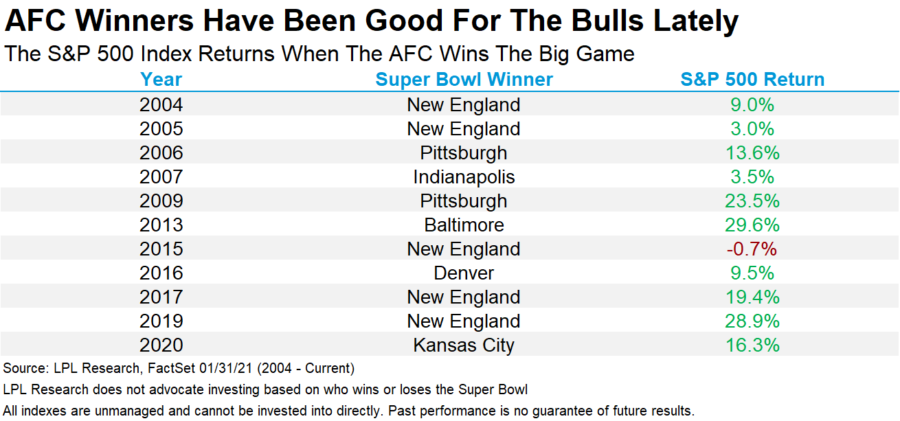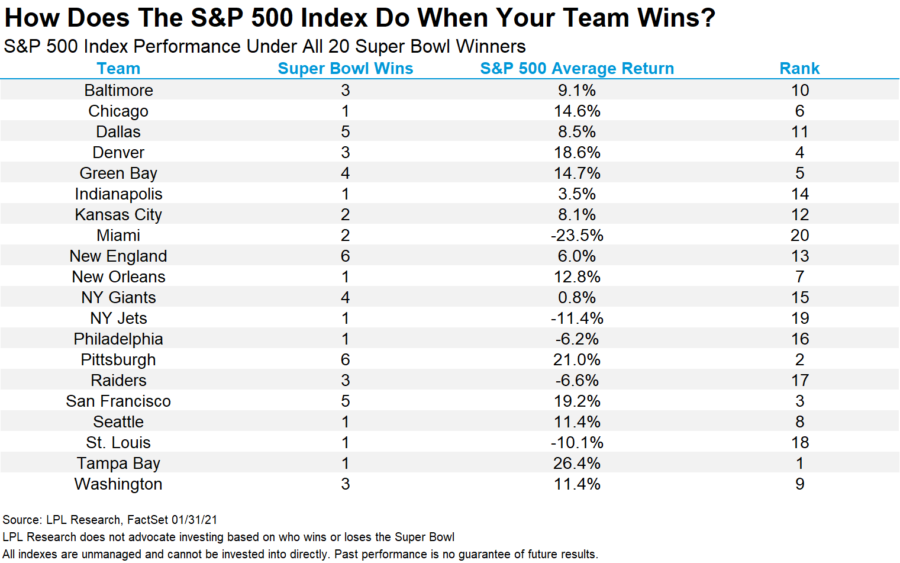Should Investors Root For Tom Brady Or Pat Mahomes?

By Ryan Detrick
The Super Bowl Indicator suggests stocks rise for the full year when the Super Bowl winner has come from the original National Football League (now the NFC), but when an original American Football League (now the AFC) team has won, stocks fall.
We would be the first to admit that this indicator has no connection to the stock market, but “data don’t lie”: The S&P 500 Index has performed better, and posted positive gains with greater frequency, over the past 54 Super Bowl games when NFC teams have won. Of course, it doesn’t always work, as stocks did quite well the past two years even though AFC teams won.
It was originally discovered in 1978 by Leonard Kopett, a sportswriter for the New York Times. Up until that point, the indicator had never been wrong.
A simpler way to look at the Super Bowl Indicator is to look at the average gain for the S&P 500 when the NFC has won versus the AFC—and ignore the history of the franchises. As shown in the LPL Chart of the Day, this similar set of criteria has produced an average price return of 10.2% when an NFC team has won, compared with a return of 7.1% with an AFC winner. An NFC winner has produced a positive year 79% of the time, while the S&P 500 has been up only 65% of the time when the winner came from the AFC.
Here’s the catch. Stocks have actually done just fine lately when the AFC has won. In fact, the S&P 500 Index gained 10 of the past 11 years after an AFC Super Bowl champ.
“There have been 54 Super Bowl winners, yet only 20 teams account for those wins,” said LPL Financial Chief Market Strategist Ryan Detrick. “And wouldn’t you know it, the best stock market performance happens after the Bucs win the big game? But I don’t care, I’m still not rooting for Tom Brady.”
Here’s a breakdown of the 20 Super Bowl winners and how the S&P 500 has done following their victories. For some reason, the author’s favorite team, The Cincinnati Bengals, isn’t on this list. We double checked the data, but they still aren’t on there.
Lastly, this is Tom Brady’s record 10th Super Bowl. It turns out; stocks don’t do well when he is in the game, up only 0.5% for the year. Meanwhile, should he lose (again, what the author is hoping for here), stocks actually do quite poorly, down 10.4% on average.
LPL Research would like to reiterate that in no way shape or form do we recommend investing based on this data, but here’s to a great game and safe Super Bowl weekend everyone!
Ryan Detrick is chief market strategist for LPL Financial








Northwestern Mutual Wins $4M Zoom Trial After Jury Rules Suicide
COVID Deaths, Product Shift Slow Lincoln Financial In 4Q
Advisor News
- Is a Roth IRA conversion key to strategic tax planning?
- Regulator group aims for reinsurance asset testing guideline by June
- Bessent confirmed as Treasury secretary
Former hedge fund guru to oversee Trump's tax cuts, deregulation and trade changes
- Jackson National study: vast underestimate of health care, LTC costs for retirement
- EDITORIAL: Home insurance, tax increases harm county’s housing options
More Advisor NewsAnnuity News
Health/Employee Benefits News
- Many died in sober living homes due to fumbled fraud response
- Let's talk about Long Term Care insurance
- Many died in sober living homes as Arizona officials fumbled Medicaid fraud response
- Peter Daniel: Government mandates are driving up healthcare costs in NC
- NC bill would limit insurers' prior authorizations
More Health/Employee Benefits NewsLife Insurance News
- Legals for January, 31 2025
- Automatic Shelf Registration Statement (Form S-3ASR)
- Best’s Special Report: Impairments in US Life/Health Insurance Industry Jump to 10 in 2023
- AM Best Maintains Under Review With Developing Implications Status for Credit Ratings of Solidarity Bahrain B.S.C.
- AM Best Maintains Under Review With Developing Implications Status for Credit Ratings of First Insurance Company
More Life Insurance News